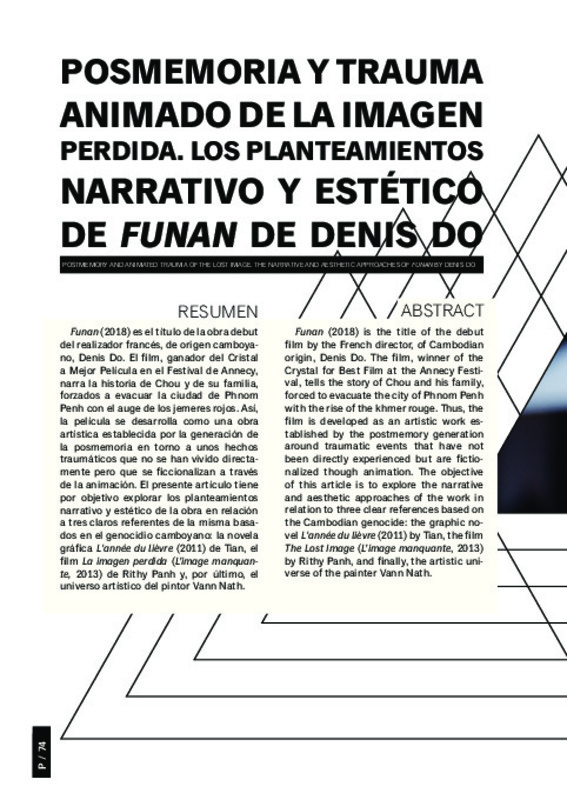JavaScript is disabled for your browser. Some features of this site may not work without it.
Buscar en RiuNet
Listar
Mi cuenta
Estadísticas
Ayuda RiuNet
Admin. UPV
Posmemoria y trauma animado de la imagen perdida. Los planteamientos narrativo y estético de Funan de Denis Do
Mostrar el registro sencillo del ítem
Ficheros en el ítem
| dc.contributor.author | Martín Sanz, Álvaro
|
es_ES |
| dc.date.accessioned | 2021-03-15T08:21:50Z | |
| dc.date.available | 2021-03-15T08:21:50Z | |
| dc.date.issued | 2021-03-10 | |
| dc.identifier.issn | 21736049 | |
| dc.identifier.uri | http://hdl.handle.net/10251/163843 | |
| dc.description.abstract | [EN] Funan (2018) is the title of the debut film by the French director, of Cambodian origin, Denis Do. The film, winner of the Crystal for Best Film at the Annecy Festival, tells the story of Chou and his family, forced to evacuate the city of Phnom Penh with the rise of the khmer rouge. Thus, the film is developed as an artistic work established by the postmemory generation around traumatic events that have not been directly experienced but are fictionalized though animation. The objective of this article is to explore the narrative and aesthetic approaches of the work in relation to three clear references based on the Cambodian genocide: the graphic novel L'année du lièvre (2011) by Tian, the film The Lost Image (L’image manquante, 2013) by Rithy Panh, and finally, the artistic universe of the painter Vann Nath. | es_ES |
| dc.description.abstract | [ES] Funan (2018) es el título de la obra debut del realizador francés, de origen camboyano, Denis Do. El film, ganador del Cristal a Mejor Película en el Festival de Annecy, narra la historia de Chou y de su familia, forzados a evacuar la ciudad de Phnom Penh con el auge de los jemeres rojos. Así, la película se desarrolla como una obra artística establecida por la generación de la posmemoria en torno a unos hechos traumáticos que no se han vivido directamente pero que se ficcionalizan a través de la animación. El presente artículo tiene por objetivo explorar los planteamientos narrativo y estético de la obra en relación a tres claros referentes de la misma basados en el genocidio camboyano: la novela gráfica L'année du lièvre (2011) de Tian, el film La imagen perdida (L’image manquante, 2013) de Rithy Panh y, por último, el universo artístico del pintor Vann Nath. | es_ES |
| dc.language | Español | es_ES |
| dc.publisher | Universitat Politècnica de València | es_ES |
| dc.relation.ispartof | Con A de animación | es_ES |
| dc.rights | Reconocimiento - No comercial - Compartir igual (by-nc-sa) | es_ES |
| dc.subject | Cambodia | es_ES |
| dc.subject | Khmer rouge | es_ES |
| dc.subject | Postmemory | es_ES |
| dc.subject | Rithy Panh | es_ES |
| dc.subject | Tian Vann Nath | es_ES |
| dc.subject | Camboya | es_ES |
| dc.subject | Jemeres rojos | es_ES |
| dc.subject | Posmemoria | es_ES |
| dc.title | Posmemoria y trauma animado de la imagen perdida. Los planteamientos narrativo y estético de Funan de Denis Do | es_ES |
| dc.title.alternative | Postmemory and animated trauma of the lost image. The narrative and aesthetic approaches of Funan by Denis Do | es_ES |
| dc.type | Artículo | es_ES |
| dc.identifier.doi | 10.4995/caa.2021.15087 | |
| dc.rights.accessRights | Abierto | es_ES |
| dc.description.bibliographicCitation | Martín Sanz, Á. (2021). Posmemoria y trauma animado de la imagen perdida. Los planteamientos narrativo y estético de Funan de Denis Do. Con A de animación. 0(12):74-93. https://doi.org/10.4995/caa.2021.15087 | es_ES |
| dc.description.accrualMethod | OJS | es_ES |
| dc.relation.publisherversion | https://doi.org/10.4995/caa.2021.15087 | es_ES |
| dc.description.upvformatpinicio | 74 | es_ES |
| dc.description.upvformatpfin | 93 | es_ES |
| dc.type.version | info:eu-repo/semantics/publishedVersion | es_ES |
| dc.description.volume | 0 | es_ES |
| dc.description.issue | 12 | es_ES |
| dc.identifier.eissn | 21733511 | |
| dc.relation.pasarela | OJS\15087 | es_ES |
| dc.description.references | MYSLIWIEC, Eva, 1988. Punishing the Poor: The International Isolation of Kampuchea, Oxford: Oxfam. | es_ES |
| dc.description.references | PONCHAUD, François, 1978. Cambodia Year Zero, Nueva York: Henry Holt & Co. | es_ES |
| dc.description.references | SPIEGELMAN, Art, 2019. Maus, Barcelona: Penguin Random House. | es_ES |
| dc.description.references | TIAN, 2011. L'année du lièvre. Au revoir Phnom Penh, París: Gallimard Jeunesse. | es_ES |
| dc.description.references | TIAN, 2013. L'année du lièvre. Ne vous inquietez pas, París: Gallimard Jeunesse. | es_ES |
| dc.description.references | TIAN, 2016. L'année du lièvre. Un nouveau départ, París: Gallimard Jeunesse. | es_ES |








